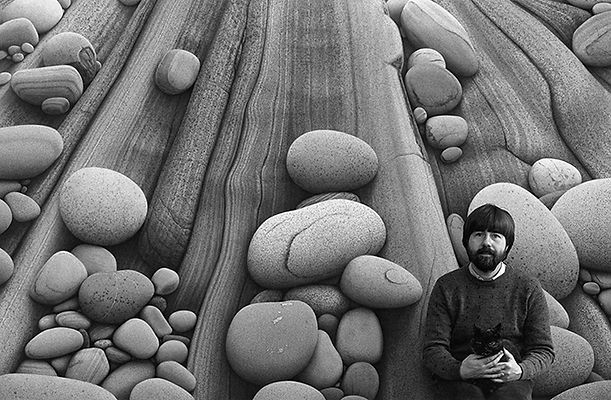ALAN MAGEE STUDIO
A painting should not mean, but be
review of Magee retrospective exhibition at the Farnsworth Art Museum
by Edgar Allen Beem, The Maine Times, May, 1984
"Description is revelation. It is not
The thing described, nor false facsimile.
It is an artificial thing that exists,
In its own seeming, plainly visible,
Yet not too closely the double of our lives,
Intenser than any actual life could be"
Wallace Stevens, Description Without Place
Though I try not to be over-awed by Alan Magee's uncanny powers of observation and reproduction, I must confess that while viewing his current exhibition at the Farnsworth Museum in Rockland, I had essentially the same reaction as a young mother who wheeled her baby into the gallery, took one look around, and exclaimed (to the child and anyone else who cared to listen), "Oh, what an artist! Gosh!”
The centerpiece of the exhibition is a 6 foot by 9 foot acrylic masterpiece, Stone Baptistery, that may well be the consummation of Magee's preternatural attachment to the stone coast at Pemaquid. In recent years, Magee has returned to this stone beach time and time again to celebrate a sense of spiritual stillness he finds there. In Stone Baptistery, armloads of rounded stones spill along a smooth ledge in a symphony of greys so stern and elemental (and exact) as to take the breath away. The placement of the forms and of the painting itself on the gallery wall are such that the viewer has a sense of being swept away by the image.
Stone Baptistery is attended by two other major acrylic stone paintings, Casting of Runes and Quartz Drawing II, as well as several watercolor images of the enchanted rocks, but the majority of the works at the Farnsworth are exquisite watercolor and colored pencil images of poetically contrived still-lifes.
In rendering his strangely (as in hauntingly) beautiful compositions of bones and boxes and bits of correspondence addresses, Magee seems to be about the business of collecting specimens for a museum of the imagination, but as he explained to me how the disparate elements of his pictures come together it became clear to me that the best analogy was to poetry.
Cool Air, for example, consists of images of mouse bones scattered over a rectangular surface addressed (as on an envelope or package) to Dr. G. Magee, 2823 North Broad Street, Philadelphia, U.S. America. At the base of the addressed surface is a small, dark square and a border of grass. At the mouth of the dark square opening are the words "cool air." Magee, who grew up in Philadelphia*, explained that the square opening was inspired by vents at the base of some old buildings in the City of Brotherly Love**. The buildings have no foundations and the vents often seem to exhale cool air onto passers-by. The rodent remains fit perfectly in this urban context. The use of family correspondence is meant to suggest historical continuity, bonds and messages along the generations.
When I suggested a correspondence between the objective correlatives of T.S. Eliot's poetry and the content of his still-lifes, Magee agreed to the parallel, but suggested a kinship to Wallace Stevens' writings and methods would be more exact. You can always count on Alan Magee to be more exact.
Lest a viewer be put off by the difficulty of "reading" his symbolism, Magee suggests that the elements of his pictures have no "narrative connection," but rather a purely "emotional connection." He does not expect viewers to "get the meaning" of his images, but to respond to them subliminally. And it is hard not to respond to a human skull balanced on an oriental tea box (Collected Letters), but Magee insists that the meaning is not literal or even symbolic, rather "the fit" (as he puts it) is conceptual, visual, and, ultimately, in the bones.
The Farnsworth exhibition is completed by a series of recent monotypes, studies of familiar Magee subjects such as isolated stones and pears, which have an oddly painterly quality coming from this master of the precise. But then in achieving the textures and markings of his apparently exact stones Magee has always relied heavily on accident (drips, splatters, wipings) and the monotypes (one-of-a-kind prints achieved by painting on metal surfaces and transferring the image to paper with the use of a press) simply explore the possibilities of the accidental more openly.
Alan Magee's superb draftsmanship makes him one of the most accessible and immediately impressive artists for a large popular audience and his innate intelligence and unerring good taste allow him to be appreciated by (at the risk of sounding elitist) more subtle sensibilities. His art is rich in both illusion and allusion, but he is careful never to use his obvious gifts merely to seduce.
Writing of Magee's stone paintings in The Christian Science Monitor, critic Theodore F. Wolff offered the opinion that, "They are, to put it simply, almost perfect and are among the best realist paintings being produced anywhere today."
I'm not going to argue with that.
MAINE TIMES, May 25, 1984
*Magee grew up in Newtown, PA
**the buildings are in Newtown, PA
